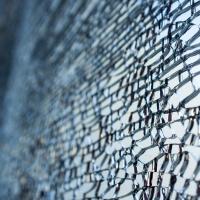Date: 19 May 2005
Someone once said that 'If glass were invented today you would not be allowed to use it as a building material.' Modern buildings tend to make great use of glass. This means that flying glass causes most blast casualties in modern towns and cities. Aside from blast casualties, serious injuries frequently occur because of what is known as Nickel Sulphide Inclusion, (also known as NiS), which causes glass to suddenly shatter and crash down on people.
Here's how to check to see if you have a weak link: Look out of your building window. Check if film protects that window. Is there a layer of polyester film applied to the glass? This is Safety Film - used to increase protection against impact and explosions. If Safety Film has not been applied you might like to check that at least you are protected by bomb resistant glass (laminated glass).
If you have Safety Film, look very carefully at where the film meets the window frame. Is there a very tiny gap - just a millimeter or so - between the edge of the Safety Film and the window frame? If there is a gap, that's your weakest Link. That gap is called the 'Danger Gap'. It means that you are not getting full protection from your Safety Film: You may have protection against flying glass but not against the whole windowpane flying into your work place or crashing down from above. It is possible to eliminate this danger gap. There are various solutions to this problem. However, you should consider obtaining expert advice (from companies like Safegard International, which has a specialist team and survey service).
There are three main methods of protection against flying glass:
1. Blast resistant glass: laminated glass. Suitable for new buildings or refurbished windows.
Laminated glass offers a higher level of protection than toughened glass. What happens when laminated glass is shattered by a blast or impact? Very large, large, medium, small or very small shards - sharp pointed pieces of glass - fly through the air.
To increase your protection, apply Anti-shatter film - Safety Film. Toughened (fully heat tempered) glass provides for safety but not complete security and is therefore not recommended for external window or door use. If it is already installed it should have anti-shatter film (safety film) applied.
2. Install blast resistant (laminated glass) secondary glazing inside exterior glazing. This is suitable for retro-fit.
3. Anti-shatter film : Safety Film. Apply transparent polyester anti-shatter film (Safety Film) to the glass. With double glazed windows consisting of two separate frames, in which the inner frame can be opened independently of the other, apply to both panes. If the inner pane cannot be opened independently, or a sealed-unit is fitted, applying film to the inner panel is tolerable.





























Add new comment